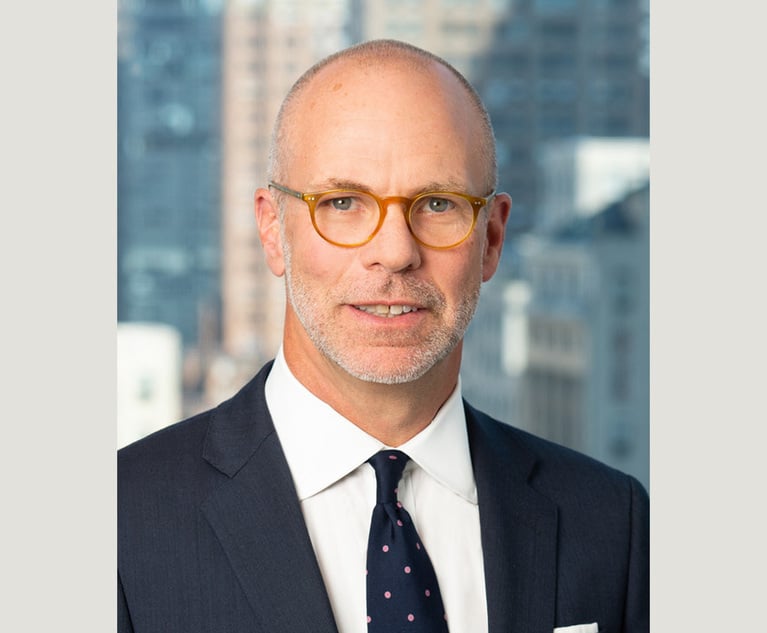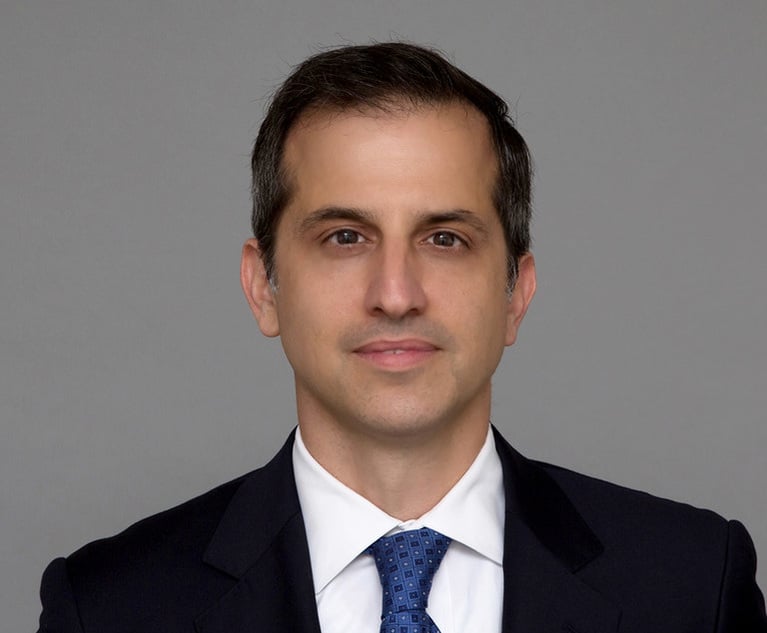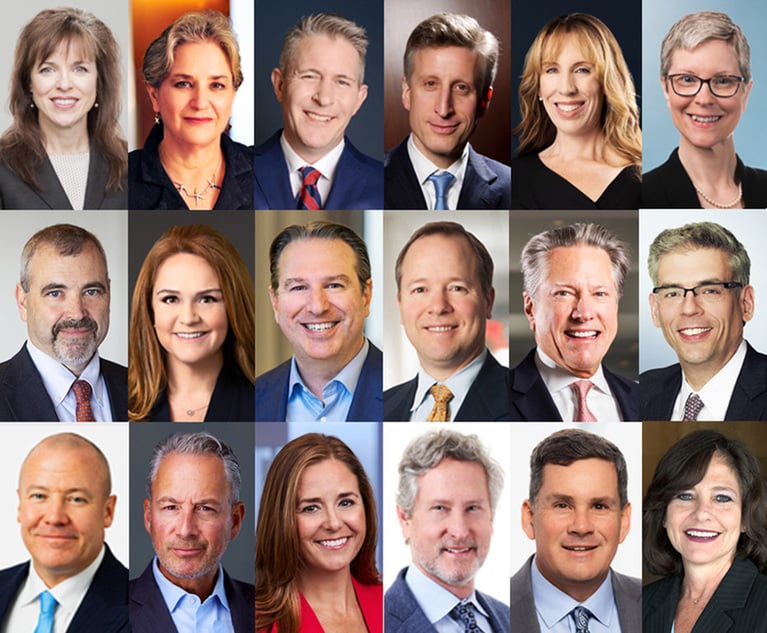Litigation Leaders: Wilmer's Howard Shapiro on 'Classic Trial Lawyering,' Suing the Government and Lateral All-Stars
'We tell clients when something isn't going to work, and we don't take unnecessary long shots,' Shapiro said. 'It can make for extraordinarily effective advocacy when it's clear you're the straight shooter in the courtroom.'
May 14, 2019 at 12:52 PM
12 minute read
 Howard Shapiro, with WilmerHale.
Howard Shapiro, with WilmerHale.
It's time for another installment of our 'Litigation Leaders' series, featuring the litigation department heads of Am Law 200 firms.
Howard Shapiro, who is based in Washington, D.C., is the chair of Wilmer Cutler Pickering Hale and Dorr's 520-lawyer litigation practice. Prior to joining the firm, he served as the general counsel of the Federal Bureau of Investigation from 1993 to 1997, and was also an AUSA in the Southern District of New York.
Lit Daily: Tell us a little about yourself—beyond what's in your law firm bio.
Howard Shapiro: I have a terrific and terrifically supportive family. When I delivered the closing in a federal criminal trial in New York last May, my wife, Shirley Brandman, and our two grown sons—Zack and Samuel—all came to town to cheer me on.
My older son, now himself a lawyer, started that practice early. When he was five weeks old, I began trying (as a prosecutor) a federal murder trial involving the mail bombing assassinations of Judge Robert Vance and civil rights attorney Robbie Robinson. After a change of venue, the trial took place in Saint Paul, Minnesota, before the legendary Judge Devitt. Since I was going to be away from home, and from my newborn child, for several weeks, Shirley moved with me and baby Zack into an apartment across the street from the courthouse.
The U.S. Marshals saved a seat by the door for Shirley to come into the courtroom carrying Zack in a Snugli—and from which she could quickly escape when he started to peep. It may have provided an unfair advantage that Judge Devitt would, from time to time, lean forward while I was at the podium and say—in a stage whisper–“Your baby's in the courtroom.” The entire jury looked and smiled. This was, happily, not an issue on appeal.
I am known to be a big fan of babies. My younger colleagues often bring their small children by to visit me in the office. I will stop almost anything to play with a small child. (Or a dog.)
How big is your litigation department and where are most of your litigators concentrated geographically?
We have more than 520 lawyers in our litigation department, with the highest number—more than 150—in Washington, DC, followed by Boston and New York, and then London. We also have a significant litigation presence on the West Coast and in Denver—and a small group in Europe.
In what three areas of litigation do you have the deepest bench?
There are more than three! We have an extraordinarily broad and deep bench of first-chair trial lawyers.
Our top practices include government-facing litigation of any sort—everything from white collar criminal defense, to False Claims Act or APA challenges, to state attorney general matters, to securities enforcement cases—as well as our celebrated intellectual property and international arbitration practices, and extensive experience handling complex commercial disputes and anti-discrimination claims, to name a few.
We try a lot of cases to verdict and have a high success rate. We are also not afraid to face off against the government when we need to, including suing them, and we have had many victories defending cases brought by the government. I recently completed a six-week trial—with an extraordinary team of trial lawyers—against the State of Washington in King County court in Seattle on behalf of one of the firm's significant clients.
What were some of your firm's biggest in-court wins in the past year?
There are many, but a standout was the stunning acquittal of former London-based foreign exchange trader Rohan Ramchandani on criminal antitrust charges in a Southern District of New York jury trial last November. SDNY acquittals of white-collar criminal defendants are rare, and our client's odds were further diminished by the fact that his former employer, Citigroup, and a group of other major banks had already pleaded guilty and agreed to pay $2.5 billion in fines for the conduct at issue.
I'd also have to point to our final victory in the patent war between Apple and Samsung. In May 2018, a jury ordered Samsung to pay Apple $539 million for infringing on its patents, and in June the parties settled, bringing an end to the long-running litigation, which was a major accomplishment for our team. The case began in 2010 and we did six trials and 14 appeals, all the way through the U.S. Supreme Court. In Apple-Samsung, our team, led by Bill Lee, litigated 59 cases in 14 countries.
Another great example from this past year is when we successfully persuaded a federal jury in Detroit to reject Jaguar Land Rover's $130 million trademark infringement claim against Canadian powersports manufacturer Bombadier Recreational Products over the use of the word “Defender” for BRP's side-by-side off-road vehicle. Land Rover had won a similar case in the EU two years ago, making this a particularly challenging case and a significant win. Louis Tompros was featured as The American Lawyer's Litigator of the Week for that impressive victory.
As head of the department, what are some of your goals or priorities?
First, we've launched a new Trials Group this year to bring together the strength of our trial practice from across the firm's various practice groups and to spread the word about the sheer volume and diversity of the cases we try. While we have a leading reputation for trial practice in IP litigation, not as many people know that in the last few years we've taken the SEC to trial five times and won four of those, or that we have many other areas of trial strength.
Second, we plan to continue building our next generation of diverse litigation leaders—an effort we began more than a decade ago. The group of litigators who have first-chaired trials or arbitrations extends way beyond our senior headliners, and it is an extremely diverse group. For example, more than 100 of the firm's female lawyers—including 23 partners—have trial experience. Diversity is highly important. Clients demand it and it makes us stronger.
Third, we know cost is always an issue for clients, even on the biggest matters. We have put in place a sophisticated matter management system that provides real-time metrics on lawyer performance and fees, and we're creative about alternative fee arrangements.
What do you see as hallmarks of your firm's litigators? What makes you different?
One thing that really stands out is our sophisticated, whole-case approach. We prize classic trial lawyering and telling the story of a case, no matter how technical the subject matter. We don't lose sight of the big-picture narrative, and all our decisions about witnesses, documents and analyses are directed toward conveying that story.
Another hallmark is that we bake in an appellate strategy from the first day. We prepare to win at trial, but we also have the appeals process in mind at all times. A good example is the Harvard trial, where we defended Harvard against claims that its admissions process discriminates against Asian-Americans. We were brought in to win the trial, but we also expect the case to reach the U.S. Supreme Court, so we developed a strategy for both, as we do in every significant case. We have the best appellate lawyers in the country. Last year, more than 30 of our lawyers presented 52 oral arguments across the United States and our lawyers have argued more than 140 cases before the Supreme Court.
Our litigators also stress integrity, honesty and forthrightness. We tell clients when something isn't going to work, and we don't take unnecessary long shots. As a result, we build credibility with judges and juries. It can make for extraordinarily effective advocacy when it's clear you're the straight shooter in the courtroom.
How many lateral litigation partners have you hired in the last 12 months? What do you look for in lateral hires?
We're choosy about bringing in laterals. We only do it when we find an all-star. For example, Brian Mahanna just joined us from the Office of the New York State Attorney General, where he was chief of staff and deputy AG. He is an important addition to our thriving state AGs practice. In 2018, we also welcomed Andrew Shipley, an esteemed litigator and leading government contracts practitioner.
We also consistently look to bring in people with a range of very high-level government experience—these are folks with names you know, such as Jamie Gorelick, Bill McLucas, Seth Waxman and Ken Salazar—but we don't bring in people just for their titles.
We want working lawyers who have real experience and are looking to serve our clients. In that regard, we're very excited that we'll soon be welcoming former SEC commissioner Dan Gallagher back to the firm as deputy chair of our Securities Department, which includes a deep bench of securities litigators focused on class actions, shareholder derivative litigation and SEC enforcement litigation.
Can you give an example or two of tactics you've employed that exemplify your firm's approach to litigating cases?
When representing individuals, it is critical to present them in the round, as opposed to the two-dimensional portraits presented by the other side.
The criminal antitrust trial of Rohan Ramchandani is a great example. Our client and his co-defendants were foreign exchange traders and the government's case played on the negative stereotypes associated with that, using out-of-context soundbites from an industry chatroom known, most unfortunately, as “the Cartel” to cast them as crass, greedy and unethical.
Our team, led by partners Heather Nyong'o, Anjan Sahni, and Thomas Mueller, called a witness who had worked as a subordinate of our client at Citibank in London—a woman who was motivated to come to the United States to testify, at the risk of being charged herself, because she was unwilling to stand by and watch our client being scapegoated for practices that were standard across the industry, and that she had followed herself. Our team felt strongly that it was important to counteract any bias the jury harbored against traders and call a witness who would show Rohan as a human being.
Our witness's testimony was the high point of the trial. It broke down that last barrier and gave the jurors permission to align their emotional side with what they knew to be logically true. As our team says, we would probably have won without this witness, but the jurors came back with an unusually swift acquittal verdict.
Similarly, with corporate clients we seek to situate the claims at issue in a trial within the larger narrative of the case. For example, we tried a case last June for Apple in the International Trade Commission. The ITC has the power to decide whether products are being “unfairly imported”—including because those products infringe U.S. patents—and if so, to issue bans on the importation of such products into the United States, a potentially quite harmful remedy.
In our case, Qualcomm had asked the ITC to issue an import ban on various iPhone models, claiming infringement of several Qualcomm patents. At trial we of course defended against the infringement claims and explained why we believed the specific claims to be incorrect. But we also placed those claims in a larger narrative and showed how Qualcomm was using the ITC case to try to force Apple to stop using one of its component suppliers, Intel, a competitor of Qualcomm.
The administrative law judge ruled in our favor on most but not all of the patent issues—but then found, in a historic decision, that even as to the one patent found to be both valid and infringed, no import ban should issue because Qualcomm was trying to injure market competition in a way that would harm the public interest. That showed that the judge understood and agreed with the larger story of that case.
Where are you looking to build or expand in the next year?
We're opening a San Francisco office this month, so that will be a big focus for our litigators, particularly as we expand our work for tech company clients, who are looking at an increasingly challenging regulatory and business landscape.
This content has been archived. It is available through our partners, LexisNexis® and Bloomberg Law.
To view this content, please continue to their sites.
Not a Lexis Subscriber?
Subscribe Now
Not a Bloomberg Law Subscriber?
Subscribe Now
NOT FOR REPRINT
© 2025 ALM Global, LLC, All Rights Reserved. Request academic re-use from www.copyright.com. All other uses, submit a request to [email protected]. For more information visit Asset & Logo Licensing.
You Might Like
View All
2024 Marked Growth On Top of Growth for Law Firm Litigation Practices. Is a Cooldown in the Offing for 2025?

Big Company Insiders See Technology-Related Disputes Teed Up for 2025

Litigation Leaders: Jason Leckerman of Ballard Spahr on Growing the Department by a Third Via Merger with Lane Powell
Trending Stories
- 1'Didn't Notice Patient Wasn't Breathing': $13.7M Verdict Against Anesthesiologists
- 2'Astronomical' Interest Rates: $1B Settlement to Resolve Allegations of 'Predatory' Lending Cancels $534M in Small-Business Debts
- 3Senator Plans to Reintroduce Bill to Split 9th Circuit
- 4Law Firms Converge to Defend HIPAA Regulation
- 5Judge Denies Retrial Bid by Ex-U.S. Sen. Menendez Over Evidentiary Error
Who Got The Work
J. Brugh Lower of Gibbons has entered an appearance for industrial equipment supplier Devco Corporation in a pending trademark infringement lawsuit. The suit, accusing the defendant of selling knock-off Graco products, was filed Dec. 18 in New Jersey District Court by Rivkin Radler on behalf of Graco Inc. and Graco Minnesota. The case, assigned to U.S. District Judge Zahid N. Quraishi, is 3:24-cv-11294, Graco Inc. et al v. Devco Corporation.
Who Got The Work
Rebecca Maller-Stein and Kent A. Yalowitz of Arnold & Porter Kaye Scholer have entered their appearances for Hanaco Venture Capital and its executives, Lior Prosor and David Frankel, in a pending securities lawsuit. The action, filed on Dec. 24 in New York Southern District Court by Zell, Aron & Co. on behalf of Goldeneye Advisors, accuses the defendants of negligently and fraudulently managing the plaintiff's $1 million investment. The case, assigned to U.S. District Judge Vernon S. Broderick, is 1:24-cv-09918, Goldeneye Advisors, LLC v. Hanaco Venture Capital, Ltd. et al.
Who Got The Work
Attorneys from A&O Shearman has stepped in as defense counsel for Toronto-Dominion Bank and other defendants in a pending securities class action. The suit, filed Dec. 11 in New York Southern District Court by Bleichmar Fonti & Auld, accuses the defendants of concealing the bank's 'pervasive' deficiencies in regards to its compliance with the Bank Secrecy Act and the quality of its anti-money laundering controls. The case, assigned to U.S. District Judge Arun Subramanian, is 1:24-cv-09445, Gonzalez v. The Toronto-Dominion Bank et al.
Who Got The Work
Crown Castle International, a Pennsylvania company providing shared communications infrastructure, has turned to Luke D. Wolf of Gordon Rees Scully Mansukhani to fend off a pending breach-of-contract lawsuit. The court action, filed Nov. 25 in Michigan Eastern District Court by Hooper Hathaway PC on behalf of The Town Residences LLC, accuses Crown Castle of failing to transfer approximately $30,000 in utility payments from T-Mobile in breach of a roof-top lease and assignment agreement. The case, assigned to U.S. District Judge Susan K. Declercq, is 2:24-cv-13131, The Town Residences LLC v. T-Mobile US, Inc. et al.
Who Got The Work
Wilfred P. Coronato and Daniel M. Schwartz of McCarter & English have stepped in as defense counsel to Electrolux Home Products Inc. in a pending product liability lawsuit. The court action, filed Nov. 26 in New York Eastern District Court by Poulos Lopiccolo PC and Nagel Rice LLP on behalf of David Stern, alleges that the defendant's refrigerators’ drawers and shelving repeatedly break and fall apart within months after purchase. The case, assigned to U.S. District Judge Joan M. Azrack, is 2:24-cv-08204, Stern v. Electrolux Home Products, Inc.
Featured Firms
Law Offices of Gary Martin Hays & Associates, P.C.
(470) 294-1674
Law Offices of Mark E. Salomone
(857) 444-6468
Smith & Hassler
(713) 739-1250







